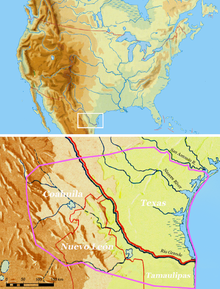 Coahuiltecan territories in the 16th and 17th centuries | |
| Total population | |
|---|---|
| merged into other groups by 1900[1] | |
| Regions with significant populations | |
| San Antonio, South Texas, U.S.; Nuevo León, Tamaulipas, and northeastern Coahuila, Mexico[1] | |
| Languages | |
| Coahuiltecan languages | |
| Religion | |
| Indigenous religion, Roman Catholicism |
The Coahuiltecan were various small, autonomous bands of Native Americans who inhabited the Rio Grande valley in what is now northeastern Mexico and southern Texas.[1] The various Coahuiltecan groups were hunter gatherers. First encountered by Europeans in the 16th century, their population declined due to European diseases, slavery, and numerous small-scale wars fought against the Spanish, criollo, Apache, and other Indigenous groups.
After the Texas secession from Mexico, Coahuiltecan peoples were largely forced into harsh living conditions. In 1886, ethnologist Albert Gatschet found the last known survivors of Coahuiltecan bands: 25 Comecrudo, 1 Cotoname, and 2 Pakawa. They were living near Reynosa, Mexico.[2]
The Coahuiltecan lived in the flat, brushy, dry country of northern Mexico and southern Texas, roughly south of a line from the Gulf Coast at the mouth of the Guadalupe River to San Antonio and westward to around Del Rio. They lived on both sides of the Rio Grande. Their neighbors along the Texas coast were the Karankawa, and inland to their northeast were the Tonkawa. To their north were the Jumano. Later the Lipan Apache and Comanche migrated into this area. Their indefinite western boundaries were the vicinity of Monclova, Coahuila, and Monterrey, Nuevo Leon, and southward to roughly the present location of Ciudad Victoria, Tamaulipas, the Sierra de Tamaulipas, and the Tropic of Cancer.
Although living near the Gulf of Mexico, most of the Coahuiltecan were inland people. Near the Gulf for more than 70 miles (110 km) both north and south of the Rio Grande, there is little fresh water. Bands thus were limited in their ability to survive near the coast and were deprived of its other resources, such as fish and shellfish, which limited the opportunity to live near and employ coastal resources.
- ^ a b c "Coahuiltecan Indians". Texas State Historical Association. 26 September 2019. Retrieved 1 July 2023.
- ^ Powell, J. W. 7th Annual Report of the Bureau of Ethnology, 1885-1886. Washington: GPO, 1891, p. 68